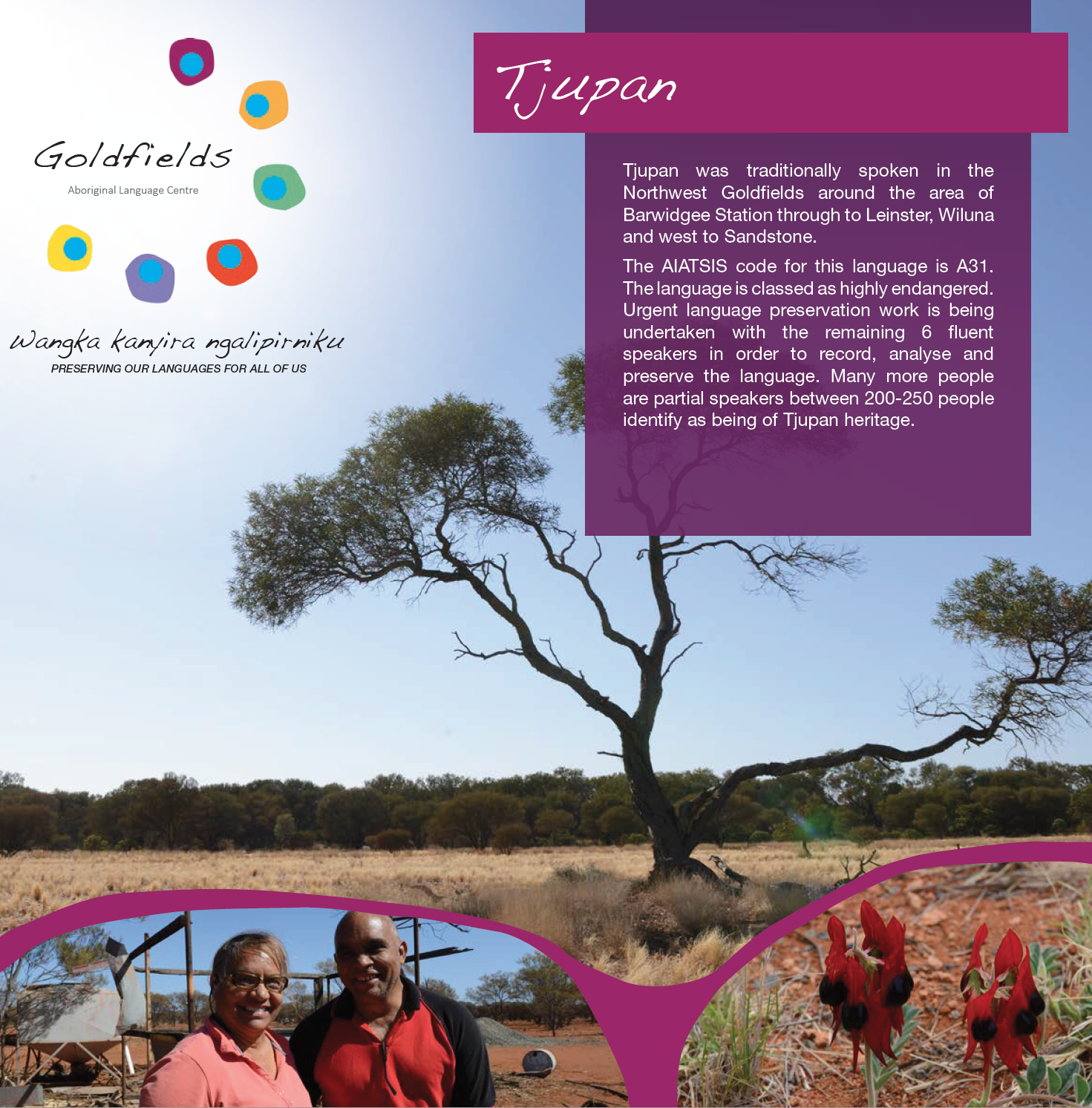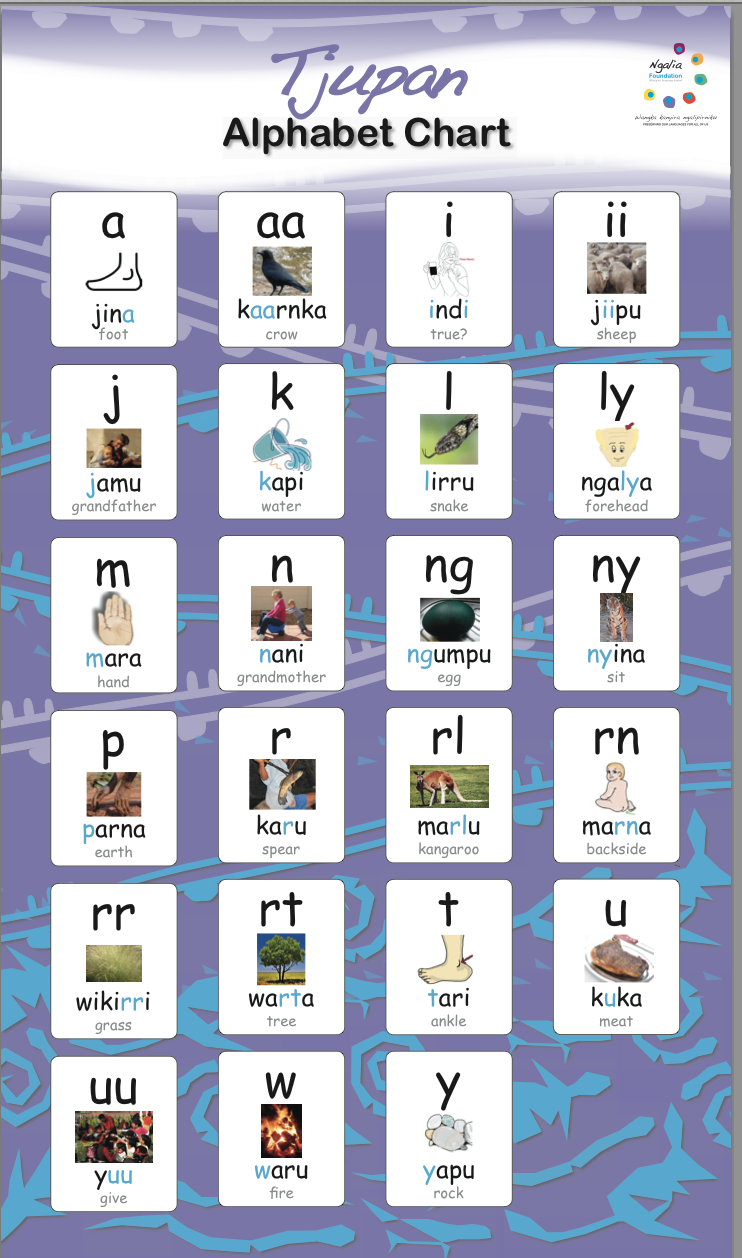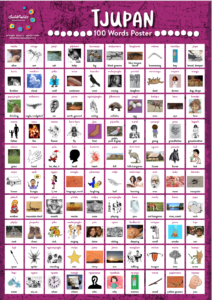
Tjupan Location
Tjupan language is from the Goldfields region in Western Australia. It is spoken by people in and around the towns of Wiluna, Leonora, Laverton and Kalgoorlie. The Tjupan people originated from the country north of Mulga Queen and across the area covered by the stations Darlot, Carnegie and Wongawol. It extends west to Sandstone, east of Agnew and Leinster and north to the town of Wiluna covering an area of 30 640 square kilometers.[1]
An ABC Open short film about Tjupan people going out for honeyants.
Tjupan Names
Tjupan has been referred to as:
- Tjalkati
- Kuwarra (This has since been proven to be a separate dialect) [2]
- Kurlujarra
- Thuradha (Bates)
- Jupan
- Tjuparn Wangka
- Tjupany
- Tjubun (Tindale 1974)
AUSTLANG states the following:
‘‘According to Oates & Oates (1970:79), von Brandenstein made some recording at Meekatharra, and Marsh is doing depth study. Liberman (1978) treats Tjupany as a dialect of Western Desert Language , but he also questions whether it refers to a separate dialect. Jessica Boynton is doing research on Tjupany (in 2008). According to Hanson (Wangka Maya 2008) Tjupan (A31) has been referred to as ‘Tjalkati’, ‘Kuwarra’, and ‘Kurlujarra’. Horton treats Tjupany and Kuwarra as distinct dialects of Western Desert Language .’ [3]
The AIATSIS code for Tjupan is A31. Tindale equates Tjupan with Pinhi (pini). It appears that Pinhi is the term used by speakers to encompass a number of Western Desert dialects of the Goldfields region of Western Australia. [4] Doug Marmion in 2008 states:
‘It appears that at least some Tjuparn (sic) people use the form tjalkakarri or tjalka-kati ‘come here’, which Bates (n.d.b) records as used by Thuradha, who identified himself as Partuwangka, and which Tindale records as a feature of his Tjalkatjarra group.
A WDL informant said that tjuparn means ‘straight’, and derives from the expressiontjuparn wangka, ‘straight talk’, which would indicate that the speech variety being referred to is the people’s own, therefore in their eyes it is the proper, correct way to talk, therefore ‘straight talk’.’ [5]
Tjupan Migration
It appears that quite a number of people (200-250) identify as of Tjupan heritage. These people are spread between Wiluna, Laverton, Leonora, Kalgoorlie and other towns and stations. The Tjupan’s relationship with traditional country appears to have been unbroken although some people were relocted to missions and stations for some time during the early European settlement phase.
State of the Language
Tjupan is a highly endangered language with very few fluent speakers remaining. A handful of people speak the language with some fluency whilst a great many are recallers. A greater number have a limited understanding of language or identify as of Tjupan heritage and speak other languages.
Currently few children are speaking or learning the language as a mother tongue.
Efforts Being Taken to Record the Language
In 2011-12, linguist Sue Hanson undertook a study of the state of the Goldfield’s languages. Tjupan speakers Shirley Wonyabong and Richard Narrier contributed words and phrases during the short study period of this project. Both speakers are very keen to see this work continue. Since 2012, Sue Hanson has worked with first language Tjupan speakers to document the language.
A thorough trawl of existing data was undertaken to locate items in historical material and records. Very few records of the language were located with a number of references made by linguists such as Tindale and Bates.
Much work remains to be done on this language. Extensive recordings of natural speech, the development of the lexical database and writing of a full descriptive grammar are amongst the most urgent of the tasks underway. Currently the lexical database (2021) stands at 2,800 entries.
[1] Tjupan Native Title claim 2005
[2] Hanson, SG Kuwarra Wordlist 2012
[3] AUSTLANG website, AIATSIS as at May 2012
[4] Geraldine Hogarth, personal communication 2012
[5] Marmion, D, Kalgoorlie Languages Inventory: Report to the Wangka Maya Pilbara Aboriginal Language Centre 2008
Tjupan Resources
Tjupan Syllables chart can be found here
Tjupan Alphabet chart can be found here Rip proof charts are available at GALCAC for $40 each

Tjupan Body Parts chart can be found here Rip proof charts are available at GALCAC for $40 each.

100 Words in Tjupan Poster
This full-colour, attractive A0 sized poster features 100 of the most common words in Tjupan. Suitable for the home, office, classroom or anywhere people want to learn language.
Available from GALCAC’s online shop or in the Language Centre in Boulder. $15 per poster and $15 per associated USB of audios.

Tjupan books available online can be found here:
Yaalu Yalkarnaka Yankupayi : Our adventures at kids
Tjupan films can be found on GALCAC’s YouTube channel: Wangka
Going to Grandmother’s Country NITV
